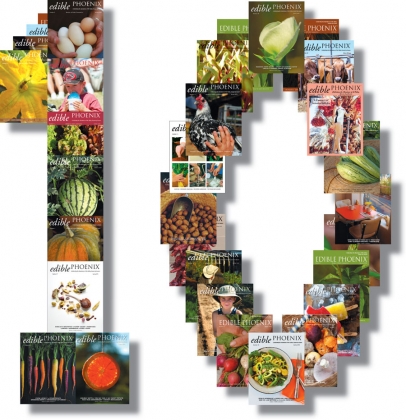Down Memory Lane: Ten Years of Valley Food, Letter From the Publisher
LETTER FROM THE PUBLISHER
As part of our anniversary celebration we’ve been perusing past issues of Edible Phoenix and looking back at changes to the Valley (and Arizona) food scene over the past 10 years. The news is mainly good—but with a few cautions. Here are a few of our observations:
1. After a rocky start at the beginning of the decade, we’ve managed to hang on to many of our farmers (and even picked up a few new ones along the way). One of the few bright spots in the recession was the slowing of the relentless takeover of Valley farmland. But with an improved economy, the Valley housing/real estate machine continues to grind on.
2. Farmers’ markets have exploded. Almost every Valley community has one, if not multiple markets. But do we have enough truly local supply to keep up with demand?
3. Community-supported agriculture (CSA) harvest subscription offerings have matured. Some of the operations have gotten out of the business or merged (Chow Locally and Blue Sky Farms being the most recent example). Most have expanded their product menus to incorporate items from other producers.
4. Arizona wine has gained respect. No longer a novelty, we’re proud to show off what our state has to offer. Vintners are still experimenting, but we’re getting closer to defining quintessential Arizona grapes. Now if we could only get the price/value equation more in line.
5. Someone once told me that where you find a vibrant local craft beer scene, you’ll find a vibrant local food scene. If that’s the case, we’re in luck. Put that in your growler and take it home.
6. Distillers are popping up all over. And they’re incorporating identifiably Arizona ingredients like mesquite, prickly pear, heirloom wheat, juniper and more. Good news for the ever-expanding craft cocktail scene.
7. Home food has enjoyed a renaissance. Crafters were encouraged by new state regulations a few years ago (although Maricopa County regulations have stymied their growth beyond farmers’ markets.) There are chickens in many yards. Home gardens and fruit trees have never been more popular. Seed saving is on the rise. We want to see more.
8. Repudiation of the no-carb trend with heirloom grain growers and processors and some of the best bread we’ve ever had, hands down.
9. More alternative dairy: goat milk and cheese, raw milk and glass-bottled milk are here. But we want to see more fresh cheeses, yogurt and creme fraiche.
10. We have more innovative, locally focused restaurants than ever before, but we still haven’t received the national recognition we deserve. Kevin Binkley’s not yet being named as a James Beard Foundation Best Chef Southwest is a case in point.
11. Great restaurants abound beyond the resorts and Scottsdale. Downtown Phoenix has been reinvigorated and neighborhood restaurants are the rage. And who other than Joe Johnston would have thought that Gilbert would be the next restaurant nexus?
12. Food trucks—hard to believe that 10 years ago they were just construction-site canteens.
13. Good food in schools has made some progress via school gardens, more fruits and vegetables and some local sourcing, but has a long way still to go.
14. There have never been so many opportunities to be enticed by Valley food photos: food bloggers, pinners, grammers, etc. You name it, they’re posting.
15. There has never been so much useful information about local Valley food producers on the web, with Good Food Finder and Fill Your Plate as cases in point.
16. And there have never been so many Valley food events—but with scores of tasting and drinking opportunities each week, have we reached the saturation point?
17. Slow Food has moved slowly forward in Arizona with a vibrant chapter in Prescott and a committed team in the Navajo nation, but with the closing of the Flagstaff chapter and a national reshuffle.
18. Community colleges, ASU and other educational institutions now have classes on sustainability, organic gardening and good food.
19. We have a sister publication (Edible Baja Arizona) in the southern part of the state but we’re still looking for an Edible to the north (Flagstaff, Sedona and Northern Arizona).
20. Despite this abundance and many innovative programs and strong efforts, food insecurity remains a major issue in the Valley and in the state. More children live in food insecure homes now than in 2005. We need to do more.
21. Edible Phoenix is still here 10 years later and flourishing (albeit now part of a much larger Edible Communities organization with magazines in over 80 communities all across the United States and Canada). Thanks to you, our readers, to our advertisers and supporters, to our many talented and generous contributors, and to our local food community, we’re looking forward to another 10 years.






